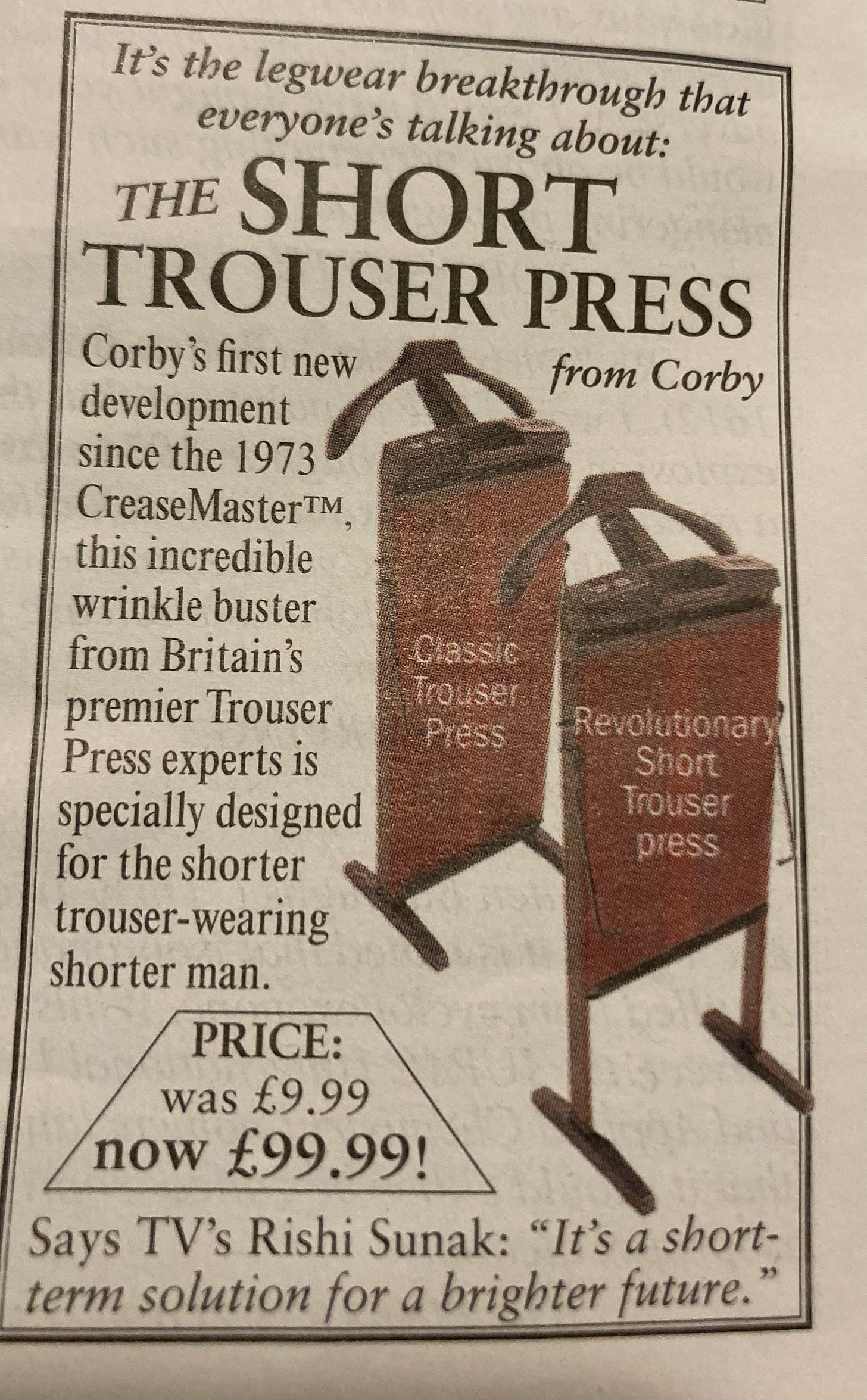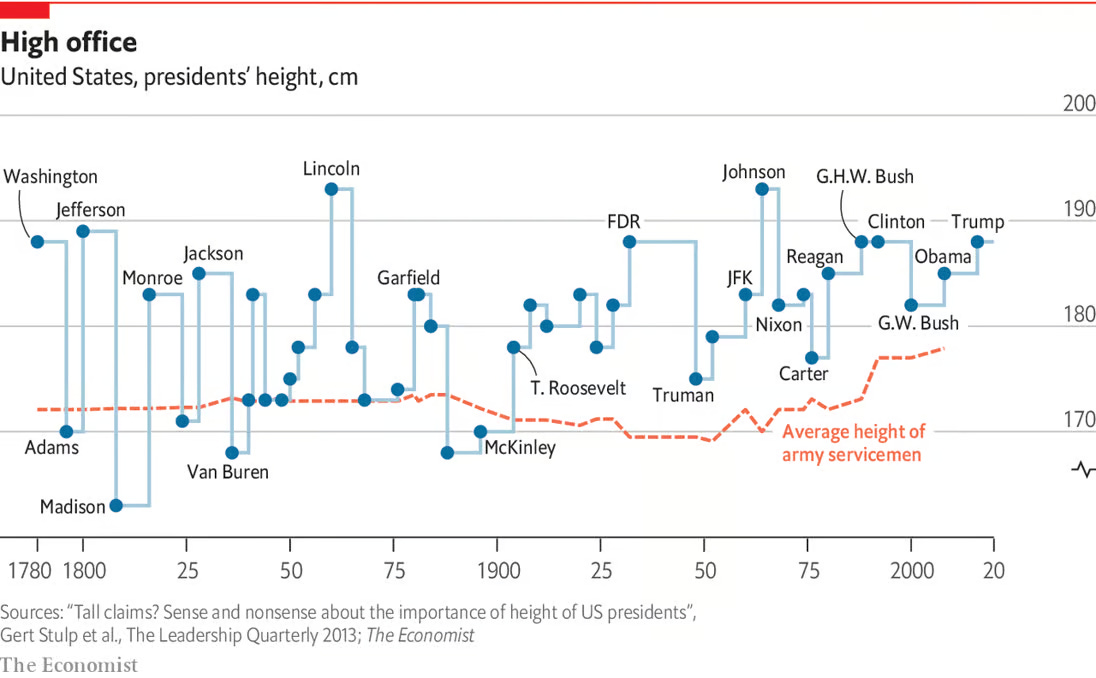Can short people do politics? Part 2
No presidential candidate has ever beaten an opponent who was more than five inches taller than them. Here's why.
These last few days have been such a joy. Meeting you all face to face and hearing so many of you say to me “Wow, you’re even shorter in real life!”
UK prime minister Rishi Sunak, 5’7’’, at the 2021 Conservative Party Conference
It can’t have escaped anyone’s notice that, before his ignominious departure from office, Donald Trump enjoyed lambasting some of his opponents like Marco Rubio with the prefix “little” when he wanted to question their fitness to hold power.
The same fate befell a senator called Bob Corker. Trump reportedly believed the 5’7’’ Tennessee Republican was too short to serve as secretary of state, a position that Trump ended up handing to the significantly taller Rex Tillerson. Corker, despite an apparently distinguished record, was branded “Liddle Bob” on the president’s Twitter feed.
Trump has somewhat of a fascination with his superior stature. We can add “Liddle Marco” and “Liddle Bob Corker,” to “Little Katy” (Tur, from NBC), and “Liddle Adam Schiff” (Democratic senator) on the suspiciously long list of opponents Trump has blasted for their size.
It doesn’t even matter if his antagonists are, in reality, short or not; Schiff is reportedly 5’11’’. Mike (“I just think of little”) Bloomberg is somewhere between 5’7’’ and 5’8’’. “Mini Mike is a short ball (very) hitter. Tiny club head speed,” Trump Tweeted, in a jibe at his opponent’s golfing ability, of all things.
While the former New York mayor’s team denied asking for a box for him to stand on when presidential candidates took to the lectern for a televised debate, you can certainly see why Bloomberg’s team might have wanted one. Trump’s eight-or-so inch gap over rival Hilary Clinton was certainly something the property mogul never went to great pains to disguise, breaking convention by passing behind her on debate stages, rather than staying on the opposite side or side by side.
Trump’s eclectic range of height-based slams aren’t aimed solely at people who are his direct rivals either, or even those who are in the same country as him, as demonstrated by him taking aim at 5’5’’ London Mayor Sadiq Khan and (roughly) 5’7’’ North Korean dictator Kim Jong Un, who he branded “Little Rocket Man” in one of his more tactful efforts at diplomacy.
In return, critics slammed Trump for having miniscule hands, leading to what I must assume were the only presidential knob gags in history, as The Donald claimed the old adage about the size of a gentleman’s hands in relation to a certain other appendage doesn’t hold true in his case. He even made sure to set the record straight, and said he didn’t have small hands, even when all the evidence suggested otherwise. Trump knows that small hands aren’t a cool look for a leader, whether they are in proportion to your tiny body or happen to be stuck on the end of a relatively large one.
But for all of Trump’s many faults, he has always been known as a man who understands what the average voter wants to hear. Judging by the numbers, they want to hear how many inches Trump and his body parts have on the other candidates.
Bloomberg himself joked back in 2006 about “what chance a 5’7’’ billionaire Jew who is divorced really has of becoming president" before launching into a discussion over how his height was a potential barrier with New York magazine. During his 2020 presidential campaign, the Bloomberg team even released a letter from his doctor confirming he was 5’7’’.
Trump can think himself lucky to have grown up physically, if not mentally or emotionally. At 6’3’’, he falls into the fortunate grouping of US presidential candidates to have been taller than their opponents when running for election. Fortunate, that is, because from 1900 to 2016, the taller candidate has triumphed in 20 of the 30 presidential races to have taken place.
Granted, 30 races is not a huge sample size to draw from. Nor is the two-thirds margin conclusive. But it speaks volumes about our tendency to reserve powerful positions in society for those with powerful physical frames.
Arguably the greatest president of them all, Abraham Lincoln, is always portrayed in a top hat. But at 6’4’’ he needn’t have worn it; he already towered ten inches over his opponent George McLellan.
An analysis by The Economist found that the height gap between presidents and the average American is growing. It was 1896 when the last man won office who was shorter than the mean height of army recruits in the same age cohort. That was William McKinley. (Right on the tip of your tongue, I know).
“A paper published in 2013, by psychologists at the University of Groningen in the Netherlands, analysed the results of American presidential elections dating back to 1789,” The Economist writes. “They found that taller candidates received more votes than shorter ones roughly two-thirds of the time. And the taller the candidates relative to their opponents, the greater the average margin of victory. Among presidents who have sought a second term, winners have been two inches taller, on average, than losers. The authors conclude that height may explain as much as 15 per cent of the variation in election outcomes.”
According to Washington Post columnist Jay Matthews, no presidential candidate has ever beaten an opponent who was more than five inches taller than them.
“I started writing about this back in 1988 - the year George H.W. Bush (6’2’’) faced off against Michael Dukakis (5’8’’) - because I thought it was wrong to judge candidates by their height,” Matthews writes. “I never imagined anyone would take my heartfelt research and use it to diminish opponents. Now I’m less eager to take credit for exposing this flaw in our system. I am afraid of what happens next.”
It’s a personal opinion held by Matthews, but not an uncommon one, that two of America’s least capable leaders - James Buchanan and Warren G. Harding - were both 6’ tall, pouring a bucket of cold water on the “Lincoln was the greatest because he was the biggest” brigade.
“Heightism is wrong,” Matthews points out, rather astutely. “The electoral bias against us short people should be exposed and eradicated.”
“I don’t have a solution yet,” he adds, equally astutely, but more disappointingly.
It’s not his fault - nobody has an answer in any world that doesn’t involve reducing leaders to floating heads, and never letting them appear in person during the entirety of their political career.
That problem of electoral bias, and the lack of solution, applies across the globe.
More on that next week.






